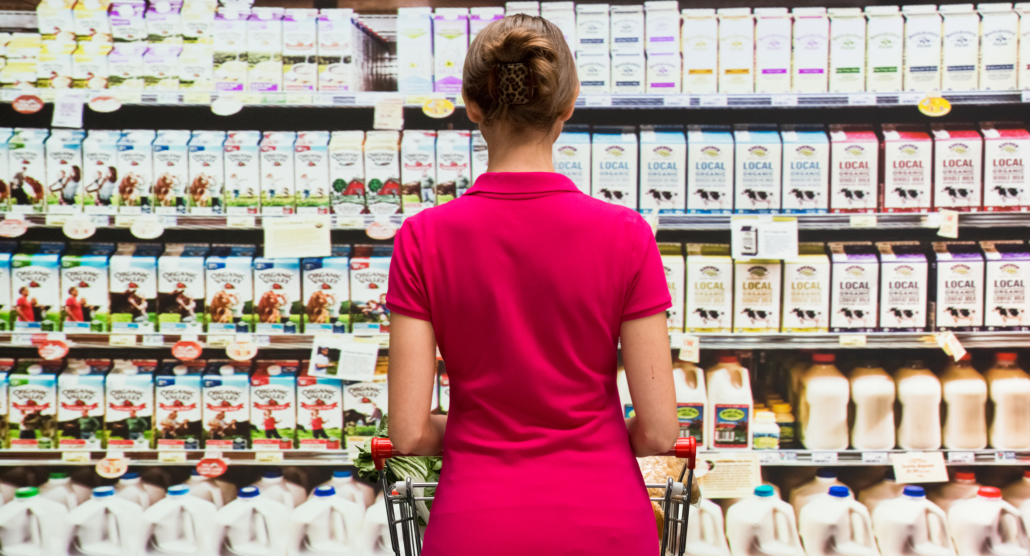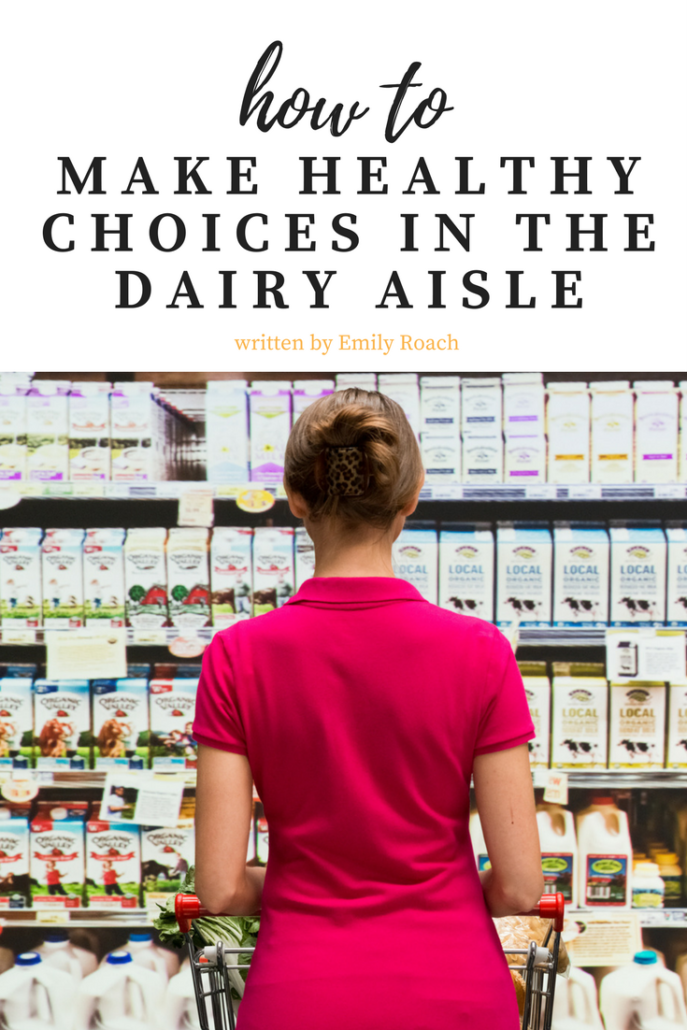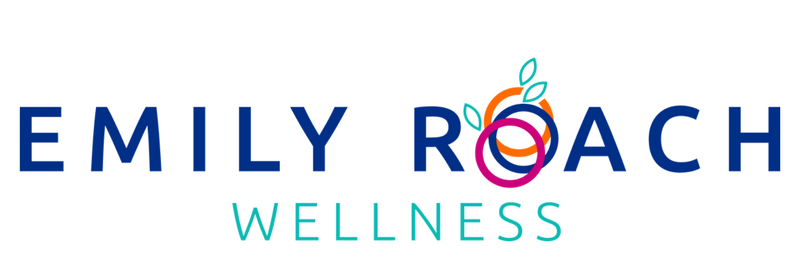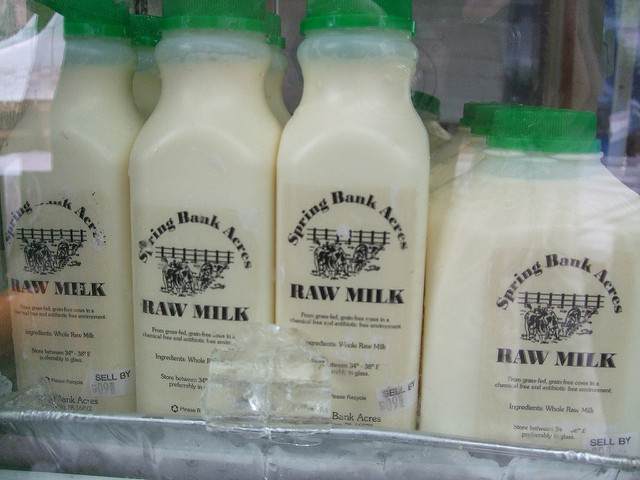It’s time to share the best dairy free products I use the most in my kitchen. Making the switch to a dairy free lifestyle can feel overwhelming at first, but I’m here to make it easier. These non dairy swaps are easy to add to your own kitchen, and help make the transition easier.
Posts
If you shop the grocery store lately, you are bound to have lots of questions about healthy dairy options. There is a giant wall of choices, and you need to understand the differences between conventional, organic, grass-fed, low-fat, fresh, and raw milk. It’s a hot topic in the nutrition field and I’m going to break it down for you.

What are the health benefits of dairy?
Milk and dairy products have been around a very long time, at least 10,000 years or more by most accounts. Fresh milk provides the following nutrients when it hasn’t been altered by pasteurization:
- fat-soluble vitamins like calcium and phosphate
- conjugated linoleic acid (an anti-inflammatory and healing fat)
- balanced amounts of essential fatty acids Omega-3 and Omega-6
- probiotics
- complete proteins, including glutathione (another anti-inflammtory)
Feeding our babies breastmilk provides all of the nutrients above, plus natural growth hormones. We are nearly all born with the ability to process lactose, the sugar in milk, but that ability begins to decrease by age 2. About 25% of Caucasians are lactose intolerant, and 97% of Native Americans are lactose-intolerant. (1) Despite our lactose intolerance issues, dairy is still recommended for children and adults.

Do we need milk for calcium?
While calcium is one of the beneficial nutrients from dairy, it’s not as readily available as the dairy businesses would like us to think. Calcium is delivered into your bones when there is a synergistic relationship between it and magnesium, vitamin K2, and vitamin D. The vitamin D added to milk after pasteurization is not well absorbed by our body. What we really want is calcium in a bioavailable form, which is found in dark leafy greens, sesame seeds, dried figs, rhubarb, and bone broth.
The second big issue with the calcium conversation is the low-fat/no-fat nonsense. If your body is in balance with the other micronutrients I mentioned, calcium needs saturated fat to be absorbed. If you eat a 0% fat yogurt, you just got zero of the calcium.
When the beneficial fat is removed from the milk, it’s replaced with carbohydrate-based fillers like cellulose, maltodextrins, gums, starches, fiber, and polydextrose. The other thing added to low-fat products is SUGAR. When you remove the fat, you remove the flavor. Added sugar is a whole other conversation, but worth noting so you skip those fruity, sugary, no-fat choices next time you are in the yogurt aisle.
Also, studies have shown there is no reduced risk for osteoporosis when drinking two or more glasses of milk a day versus two glasses per week. (2) You are better off protecting your bones by eating a plant-rich diet and incorporating movement into your lifestyle.
What’s the downside of dairy?
Conventional dairy products typically cause your body to go into a proinflammatory state. It can cause leaky gut syndrome, insulin resistance, and development of gut dysbiosis. The main goal I have when creating a healing diet is to reduce the overall inflammation levels in your body. In this day and age, our bodies are taxed by environmental toxins all the time. We can’t always control that, but we can control what we choose to eat.
As someone who creates healing diets for clients, often I work with people to eliminate dairy from their diet. Why? Eliminating dairy gives you the opportunity to see if you can reduce issues related to digestion, skin (acne/rosacea/eczema), asthma, candida, joint pain, allergies, and headaches. When you reduce overall gut irritation, you actually make it possible for your body to absorb nutrients better from the other foods you eat.
Organic versus conventional dairy?
Milk quality has improved in recent years as companies realize customers do not want antibiotics in the glass of milk they serve their kids. However, if you do not choose organic milk, you will be exposed to pesticides. They exist in the grains fed to the cows, which then goes right into the milk. The toxins actually bind with the fat in milk and they are not eliminated by pasteurization. Always purchase organic milk to avoid the toxic exposure. Remember, this applies to all your dairy products: ice cream, cream cheese, cheese, sour cream, creamer, and so on. The conventional milk used for these products is pro-inflammatory which is exactly what I teach my clients to avoid.
What happens when milk is pasteurized?
Pasteurization is the process of heating milk to very high temperatures to kill off any bacteria, or microbes, present. It came into practice in the 1800s when we didn’t have the clean facilities to gather milk on a regular basis. The demand was increasing during the time of industrialization and pasteurization allows for milk to be produced cheaply, which is what the big dairy businesses needed. Homogenized milk was the next change, where milk fat is separated so the cream no longer rises to the top. So what does this do to our milk?
Pasteurized milk has no live bacteria, compared to raw milk that may have lactobacilli present. You know, those probiotics you pay for in a bottle used to come from a glass of milk. Heat from pasteurization breaks down the proteins and fat, resulting in health-damaging consequences. The new milk creates a milk-fat soap through saponification. This creates a product that irritates your gut and can cause either diarrhea or constipation. The nutrients we want from milk, like calcium and phosphate, are now much less bioavailable and difficult to absorb. It’s about a 6-fold drop in nutrition when comparing fresh milk to pasteurized milk. (3) The amino acids are damaged with the heat and then turned into pro-inflammatory irritants, or allergens.
Where can I get healthy dairy options?
Yogurt is still the one dairy option I recommend keeping in your diet, if you are able to tolerate it. The good news is that fermentation rejuvenates the damaged proteins and makes the minerals we need more bioavailable. You want to find whole milk, grass-fed, organic yogurt in the plain variety. Skip the flavored options and just add your own raw honey or maple syrup if you need a little sweetness.

Raw milk is becoming more available across the United States, however it is still illegal to sell in Canada. To find raw milk farmers near you, head over to Real Milk to see a state by state guide. This is the place to know your farmer, visit the farm, and talk about the safety of the milk. There was a lot of scare tactics used when pasteurization came into effect at the turn of the century. As we move towards getting more food closer to the source, I hope raw milk will become widely available. What I don’t understand is why we can buy soda and cigarettes that cause obesity and cancer, but not raw milk. As a healthy dairy option, the amount of regulation against raw milk surprises me.
[clickToTweet tweet=”Dairy decisions: Why can we buy soda & cigarettes that cause obesity & cancer, but not raw milk? ” quote=”What I don’t understand is why we can buy soda and cigarettes that cause obesity and cancer, but not raw milk. “]
Spring is actually the best time to introduce yourself to raw milk as the animals will be eating fresh, growing grass. I can’t get raw milk here in Canada, but I’ve already talked to the owners of a raw milk dairy back home during my time working on a farmer’s market. They were allowed to sell raw milk cheese at the market and it was amazing!
Here’s my recommendation for healthy dairy options in order of preference:
- Eliminate dairy for two weeks to see how your health may improve. Add back in and notice if you see any changes.
- Raw milk if you can find a quality source.
- Yogurt made with Organic, grass-fed milk. Plain flavor.
- Organic grass-fed milk (cow/sheep/goat) whole milk.
- Organic milk, whole milk.
If you wish to continue on the non-dairy train, you can read my tutorial here on how to make your own almond milk. Coconut milk, cashew milk, hemp seed milk and rice milk are all available at many stores. I don’t recommend soy milk as it will be a GMO product unless it’s listed as organic. You can find lots of recipes in my meal plan section that includes primarily dairy-free options.
Is it easy to go dairy free? Yes and no. I no longer drink milk but find I can tolerate a quality yogurt or cheese here or there. More often I’m going to make a homemade coconut milk yogurt instead. My kids however LOVE their cold cereal and milk in the morning. It’s a treat they get occasionally so I invest in the best milk and organic cereal I can find. It’s not a perfect solution, but it’s working for us right now. Progress, not perfection.
Will I let them try raw milk down the road? Yes, once I get to know the farming practices in detail and can trust the safety of the milk. I would rather they get the full benefit of the vitamins and minerals in milk instead of a watered down version.
Leave a note in the comments if you have questions. Thanks for taking the time to empower yourself with information about choosing healthy dairy options.

Healthy Dairy Options Additional resources
The Big Fat Surprise: discusses the need for fat in our diet.
Devil in the Milk: Illness, Health and Politics of A1 and A2 milk. : further reading to learn about the various qualities of milk
The Paleo Approach: in depth look at why eliminating dairy can lead to optimal health, especially for women with autoimmune conditions.
Click here for a report card on your favorite organic milks to see how they stack up to the competition. There is also a yogurt one on this site too. I learned that Organic Valley is a better option than Horizon. Horizon is organic, but it’s mass produced and the nutrient quality is not the same as using milk from grass-fed animals. Their cows may be getting organic grain feed, which isn’t going to produce a premium product.
Sources
- The Paleo Approach, pg 106
- Feskanich, D., W. C. Willett, M. J. Stampfer, and G. A. Colditz. “Milk, Dietary Calcium, and Bone Fractures in Women: A 12-year Prospective Study.” American Journal of Public Health. U.S. National Library of Medicine, June 1997. Web. 06 Apr. 2017.
- Roig, M.j., A. AlegrıÌa, R. Barberá, R. Farré, and M.j. Lagarda. “Calcium Dialysability as an Estimation of Bioavailability in Human Milk, Cow Milk and Infant Formulas.” Food Chemistry 64.3 (1999): 403-09. Web.
I have taught my eight year old daughter how to make almond milk so I think it’s time I teach all of you. It’s a lot easier than you think. With just two ingredients, almonds and water, you can create fresh almond milk. No added preservatives, “gums” or questionable ingredients. Just straight up homemade almond milk. It’s a normal part of our routine in the kitchen and we make it usually 3-4 times per week.

Why am I using almond milk anyways? Dairy is often very hard for us to digest, and is a cause for issues like constipation, IBS, the runs, skin breakouts, and more. Eliminating dairy is a great way to help improve your health. Conventional dairy is so full of junk it’s no wonder it causes digestive upset. But even quality, organic milk does the same thing. Depending on your ethnicity, you have a 25 to 97 percent chance of not being able to digest lactose, a sugar found in dairy products.(source)
Almond milk can be used as milk in your baking recipes, your morning coffee or tea, or in some homemade granola. I love to use it for making elixirs, like turmeric lattes, or homemade hot cocoa for the kids. Do my children drink almond milk at dinner? No, instead we look for grass-fed, organic full fat milk. I offer it sparingly as dairy for children can often be the root cause of their ongoing bouts of the sniffles. Raw, unpasteurized grass fed milk is the very best, but very difficult to obtain. It’s still illegal in some states, but I see this beginning to change. To look for raw milk in your area, check out the Real Milk site.

A quick note about soaking your almonds. Soak the almonds in clean water for at least 6 hours to remove phytic acid. Often I will soak them overnight and process in the morning. You can see in the picture below what the water will look like after soaking is complete. Rinse away the phytic acid that has been drawn out. The acid is what makes nuts hard to digest. Now you have washed it away and are left with the good parts of the almond.
TWO KEY TOOLS YOU NEED TO MAKE ALMOND MILK.
- Nut milk bag
- High speed blender
I find the smaller size nut milk bag much easier to manage. This is one I recommend off Amazon, but you can also find them at Whole Foods or your local health food store. For blenders, the high speed ones include the Vitamix, or the Blendtec which I use. (I’ve have a refurbished one it’s going on 4 years.) I can’t speak to other blenders, like KitchenAid’s new one, but if you have it and it works for you, let me know! If only these blenders were quieter I would be delighted.
HOW TO MAKE ALMOND MILK

Phytic acid is considered an “anti-nutrient,” making it harder for your body to absorb vitamins and minerals available from food.
Soaking
- Measure 1 cup of raw almonds and place in a medium bowl.
- Cover with filtered water until the almonds submerged, and covered by an additional 3″ of water.
- Let this bowl sit on your countertop for 6 hours, or overnight.


Blending
- Using a fine mesh strainer, drain and rinse your almonds. Dispose of the old water.
- In a high speed blender, measure 4 cups filtered water.
- Add almonds and blend on high for 1 minute.

Straining
- Holding a nut milk bag over a large bowl, pour the almond milk mixture into the bag.
- Squeeze all the milk you can out of the nut bag.

Storage
- Transfer almond milk to glass containers and store in the refrigerator. It will last at least one week. (although mine is gone before then!) These caps are awesome for pouring almond milk.
- Toss the almond pulp, or store in glass container to use later.
You can use the almond pulp for almond coconut macaroon cookies or almond pulp truffles. Here’s a great round up from my CNE program here of how to use leftover almond pulp. A fellow CNE grad Jessica Grosman also created this Chocolate Mousse recipe with leftover pulp.

Let me know if you try to make your own almond milk. Don’t let this happen to you…our kids all love having a turn squeezing the milk out. Turns out it’s best to just let one kid at a time be a helper. We ended up with milk and almond pulp everyone after this picture was taken for my homework assignment this fall. What a mess! After restraining it all was not lost. Let me know if you have any hiccups with making your own almond milk. I may have already gone through it before!
I actually learned how to make almond milk when I first looked into The Academy of Culinary Nutrition. When I saw the teacher make the milk in a video and I realized how easy it is. I promise you this is one of the easiest recipes you can master and test out in your kitchen.
Free Meal Plan
Sitemap
SEARCH




